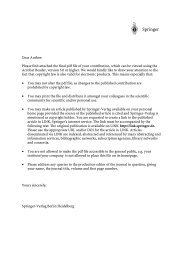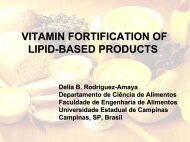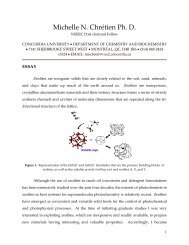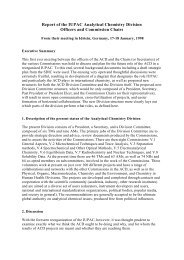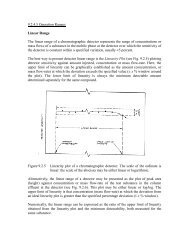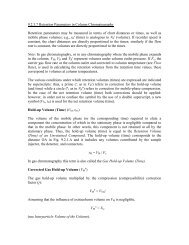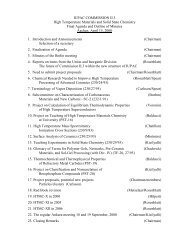Soybean Oil Processing
Soybean Oil Processing
Soybean Oil Processing
Create successful ePaper yourself
Turn your PDF publications into a flip-book with our unique Google optimized e-Paper software.
<strong>Soybean</strong> <strong>Oil</strong> <strong>Processing</strong>;<br />
Quality Criteria and Flavor<br />
Reversion<br />
Ignace Debruyne PhD<br />
PhD, Technical & Marketing Consultant<br />
American <strong>Soybean</strong> Association - Europe & Maghreb<br />
ignace.debruyne@advalvas.be
♦Flavor Reversion<br />
♦Critical Parameters<br />
♦Quality Management
<strong>Soybean</strong> <strong>Oil</strong> Flavor Reversion<br />
♦ <strong>Soybean</strong> oil is highly susceptible to oxidation<br />
The polyunsaturated fatty acid content is high: 57-58%<br />
The linolenic acid content is high: about 7%<br />
♦ The flavor of the refined oil reverts back to that of<br />
the crude oil<br />
Flavor is changing to slight beany,<br />
which in advanced stages is described<br />
as painty or fishy
Hypothesis flavor Reversion (1)<br />
♦Oxidation of linolenic acid<br />
Oxidative decomposition of linolenic acid<br />
Low linolenic soybean oil develops less<br />
reversion flavor<br />
However, nitrogen blanketing does not<br />
prevent it completely<br />
Oxidation of iso-linoleic acid? But<br />
reversion taste is not the same in brushhydrogenated<br />
oil
Hypothesis flavor Reversion (2)<br />
♦Phosphatide reaction<br />
Nitrogen is part of molecules found in the<br />
flavor extracts of reverted soybean oil<br />
Lecithin provides the trimethylamine<br />
oxide, which in the presence of linolenic<br />
acid and hydroperoxides from autooxidation,<br />
releases formaldehyde and<br />
dimethylamine (= fishy odor)
Hypothesis flavor Reversion (3)<br />
♦Unsaponifiables<br />
Induce reversion when added to other oils<br />
Flavor reversion is improved by removing<br />
unsaponifiables with adsorbents or by drastic<br />
steam deodorization<br />
♦Oxidized polymers<br />
Oxidized ethyl linolenic polymers could<br />
decompose under nitrogen<br />
This yields flavor components identical to those<br />
isolated from reverted soybean oil
Summary: flavor reversion<br />
Flavor reversion is an oxidation<br />
process involving<br />
(Poly)unsaturated fatty acids:<br />
Linolenic > Linoleic > Oleic<br />
Unsaponifiable components<br />
Nitrogenous materials:<br />
phosphatides; other
Relative oxidation rate of poly-<br />
unsaturated fatty acids at 37°C<br />
Relative rate of oxidation<br />
50<br />
40<br />
30<br />
20<br />
10<br />
0<br />
1<br />
10<br />
21<br />
C18:1 C18:2 C18:3 C20:4 C22:6<br />
E.N.Frankel (1998) Lipid Oxidation, The <strong>Oil</strong>y Press, Dundee<br />
29<br />
51
Relative stability of oils and fats<br />
<strong>Oil</strong> type OSI (h)<br />
Relative stability<br />
Fish oil<br />
@ 97.8°C<br />
2-3<br />
1<br />
Linseed oil 1-2 < 1<br />
Sunflower seed oil 8-10 4<br />
<strong>Soybean</strong> oil 13-15<br />
6<br />
Rapeseed oil 16-20 7<br />
Palm oil 40-65<br />
20
Radical driven oxidation reactions<br />
♦ Initiation RH Energy Catalyst R . + . H<br />
♦ Propagation R . + O 2 ROO .<br />
ROO . + RH ROOH + R .<br />
♦ Termination R . + R .<br />
RH +<br />
RR<br />
. OH R . ROO<br />
+ H2O . + . R<br />
ROO<br />
ROOR<br />
. + R1OO .<br />
ROOR1 + O2
Oxidation: conjugated acids formed
Critical Factors in flavor Reversion<br />
♦Factors contributing to the oxidative<br />
deterioration of finished oil (according to<br />
decreasing importance)<br />
Oxygen or air (O 2)<br />
Heat (T)<br />
Pro-oxidants (metals)<br />
Light (λ)<br />
Time (t)<br />
♦Factors related to processing (in)efficiency<br />
Crude oil quality<br />
<strong>Processing</strong> specifications
Oxygen or air (O 2 )<br />
Solubility of O 2 in oil is high: 3.2 ml / 100 ml.<br />
But oxidation can be initiated at much lower O 2<br />
concentrations!<br />
Avoid exposure to air during processing<br />
Avoid spraying in the air during filling and emptying of<br />
storage or holding tanks<br />
Use proper agitation systems in holding / storage tanks<br />
Avoid leakage at joints, fittings, or faulty pump seals<br />
Maintain vacuum where possible<br />
Avoid / eliminate the blowing of lines with air (use N 2)<br />
Protect oil with nitrogen blanketing or sparging<br />
Use anti-oxidant where possible
Heat (T)<br />
Chemical reactions, incl. oxidation, accelerate<br />
with increasing temperature<br />
♦Keep the oil no warmer than needed<br />
♦Avoid localized overheating by agitating the<br />
oil when it is heated<br />
♦Keep the storage temperature as low as<br />
possible<br />
Remark: even at low temperature sensitive lipids are<br />
prone to oxidation: e.g. frozen meat will oxidize<br />
upon storage at –20°C
Pro-oxidants (metals)<br />
Copper (Cu), the most potent oxidation catalyst<br />
and Iron (Fe) should be kept as low as possible<br />
Cu < 5 ppb<br />
Fe < 150 ppb<br />
Role for cobalt, manganese and chromium?<br />
♦ Use a chelating agent such as citric acid or<br />
phosphoric acid<br />
♦ Avoid using iron or copper (bronze) in systems<br />
coming into contact with (finished) oil
Light (λ) Time (t)<br />
♦ Protect the oil from<br />
exposure to light<br />
♦ Add single oxygen<br />
quenchers such as<br />
beta-carotene and<br />
tocopherols<br />
♦ Use appropriate<br />
refining conditions<br />
that reduce the photosensitizer<br />
content<br />
♦ When given sufficient<br />
time, any fat or oil will<br />
deteriorate even if<br />
handled under ideal<br />
conditions
Cycle of lipid oxidation
Cycle of lipid oxidation<br />
One Way Reaction
Cycle of lipid oxidation<br />
RADICAL-Scavenger<br />
Metal chelators<br />
RADICAL-Scavenger<br />
Oxygen scavenger
Balance antioxidants - radicals<br />
In-vivo antioxidants<br />
(e.g. α-tocopherol)<br />
In-vitro antioxidants<br />
BHA, BHT,…<br />
Antioxidants<br />
Antioxidants<br />
Relative<br />
Oxidative<br />
Stress<br />
Relative<br />
Oxidative<br />
Stress
Types of antioxidants<br />
♦ Metal chelators<br />
Citric acid<br />
Phosphoric acid<br />
♦ Oxygen scavengers<br />
Ascorbic acid<br />
♦ Radical scavengers<br />
Synthetic antioxidants : BHA, BHT<br />
Semi- natural antioxidants : gallic acid, propyl<br />
gallate<br />
Natural antioxidants : tocopherols, rosemary extract
Metal chelators<br />
bind metal ions, e.g. neutralization of copper or<br />
metal ions with citric acid (or with EDTA)<br />
CH 2COOH<br />
HOCCOOH<br />
CH 2COOH<br />
Citric acid<br />
+ Cu ++<br />
O<br />
− OOC CH2 C<br />
C O HO C<br />
CH 2<br />
COO −<br />
Cu+<br />
+<br />
OH O C<br />
COO −<br />
CH 2<br />
O<br />
CH 2<br />
COO −
Radical Scavengers<br />
OCH 3<br />
OH<br />
BHA<br />
OCH 3<br />
OH<br />
2- and 3-tert-butyl-4-methoxyphenol<br />
OCH 3<br />
OH<br />
OH<br />
BHT<br />
2,6-di-tert-butyl-4-methylphenol<br />
HO<br />
OCH 3<br />
. + +<br />
O<br />
O<br />
OH<br />
O<br />
OH<br />
Propyl gallate<br />
R R-H<br />
radical scavengers<br />
“absorb” free radicals<br />
.<br />
CH 3
Increasing<br />
antioxidant<br />
activity<br />
HO<br />
Tocopherols<br />
HO<br />
HO<br />
O<br />
O<br />
O<br />
α-tocopherol<br />
γ-tocopherol<br />
δ-tocopherol<br />
Increasing<br />
vitamin E<br />
activity
Factors related to<br />
processing (in)efficiency<br />
♦The quality of fully refined soybean oil is<br />
influenced by the quality of the crude oil<br />
and the quality of soybeans from which it<br />
was extracted<br />
♦The refining, bleaching and deodorizing<br />
should be done according to the best<br />
available technology – agreed Process<br />
Standards
Factors in crude SB/SBO affecting quality<br />
a Total Gums/Phosphatides b Non-Hydratable Phosphatides<br />
c Free Fatty Acids d Oxidation Products<br />
e Iron/Metal Content f Pigments<br />
♦ Field Damaged Beans a, b, c, e<br />
♦ Weed Seed d, f<br />
♦ Immature Beans f<br />
♦ Splits (Loading/Transport/Unloading) a, b, c<br />
♦ Bean Drying & Storage (t/T/Humidity) a, b, c, d<br />
♦ Conditioning Beans for Extraction a, b, d, e<br />
♦ Solvent Stripping <strong>Oil</strong> (Overheating) b, d<br />
♦ <strong>Oil</strong> from Stripper (Overheating) b<br />
♦ Crude <strong>Oil</strong> Storage (Time/Temp) c, d
Quality soybeans ⇒ Quality Crude oil<br />
♦ Optimal range for effective<br />
crushing and dehulling :<br />
DM = 9.5-10.5%.<br />
Depends on:<br />
Growing conditions<br />
Harvesting conditions<br />
Storage conditions (cleanliness?<br />
open air contact in silos, containers,<br />
trucks, trains and ships?)<br />
♦ Poor drying and storage<br />
conditions induce hydrolysis and<br />
oxidation that will partially be<br />
found in the crude oil<br />
♦ (Heat) damage<br />
Ground or weather<br />
damage<br />
Frost damage<br />
Immature soybeans<br />
Insect damage<br />
Mould damage<br />
Microbial damage<br />
Sprout damage<br />
Heat damage<br />
(inappropriate drying)
Effect of <strong>Soybean</strong> Damage on SBO Quality<br />
♦ Lower yield of crude soybean oil<br />
♦ Problems in the oil extractor<br />
♦ Too high green color in RBD SBO<br />
♦ Higher levels of Free Fatty Acids<br />
♦ Losses in the refining process of SBO<br />
♦ More impurities to remove in bleaching<br />
♦ Changes in the flavor and odor of SBO<br />
♦ Shorter shelf-life of the SBO
In-Process (<strong>Oil</strong>) Standards<br />
This is the heart of quality management<br />
Process & quality personnel need to know and be able<br />
to follow-up all in-process standards<br />
♦Standards<br />
Start at the oilseed quality and crude oil production<br />
End at the warehousing & distribution<br />
♦Standards are set<br />
On the basis of oil type and specific processes applied<br />
To maintain the best quality and maximum shelf life for<br />
the oil product
Average Compositions for Crude<br />
and Refined <strong>Soybean</strong> <strong>Oil</strong><br />
Crude <strong>Oil</strong> Refined <strong>Oil</strong><br />
Triglycerides (%) 95-97 99<br />
Phosphatides (%) 1.5 – 2.5 0.003 – 0.045<br />
Unsaponifiable matter (%) 1.6 0.3<br />
Plant sterols (%) 0.33 0.13<br />
Tocopherols (%) 0.15 – 0.21 0.11 – 0.18<br />
Hydrocarbons(squalene) (%) 0.014 0.01<br />
Free fatty acids (%) 0.3 – 0.7 < 0.05<br />
Trace metals<br />
Iron (ppm) 1 – 3 0.10-0.20<br />
Copper (ppb) 30-50 10-30<br />
Specifications may be added for moisture and secondary oxidation products
Critical parameters to be controlled in<br />
a good quality refining process (1)<br />
Start with acceptable crude oil quality<br />
within basic quality parameters<br />
Moisture < 0.15 %<br />
Peroxide value < 5 meq/kg<br />
Anisidine value < 2<br />
Below limit secondary oxidation products
Critical parameters to be controlled in<br />
a good quality refining process (2)<br />
Crude oil storage<br />
Fill and keep tanks below critical<br />
temperature<br />
preferably at 35-40 °C; never exceed 65 °C!!!<br />
Bottom filling is preferred (minimize<br />
contact with air)<br />
Work with mechanically agitated storage<br />
tanks
Significance of Equipping Edible <strong>Oil</strong><br />
Storage Tanks with Mechanical Agitators<br />
This avoids sludge formation, reduces the losses and creates a more<br />
stabilized supply of feedstock crude oil.<br />
It is also essential to achieve (1) product quality and (2) processing<br />
economic objectives.<br />
♦ Maintain oil homogeneity from crude state to finished product<br />
With static storage conditions, gravity-gradient stratification occurs<br />
The quality of the oil constantly changes<br />
It is impossible to establish stable optimum processing conditions<br />
End result: reduced oil quality, higher oil loss, and increased operating<br />
expense<br />
♦ Homogeneity in storage tanks<br />
Cannot be obtained by expensive circulating of the oil with a pump<br />
Is obtained with mechanical agitators<br />
© 2001 The Core Team ®
Critical parameters to be controlled<br />
in a good quality refining process (3)<br />
♦Equipment constraints: no copper, zinc or<br />
bronze connections, valves, pipes<br />
♦Preferably equipment is made in stainless steel:<br />
Inox 304 (high temperature), or<br />
Inox 316 (bleaching, deodorizing)<br />
♦<strong>Oil</strong> contact with air: max. temperature 65°C<br />
♦<strong>Oil</strong> contact temperature in pumps: max. 100°C<br />
(risk for air contact at higher temperature)
Critical parameters to be controlled in<br />
a good quality refining process (4)<br />
♦ <strong>Oil</strong> quality at entry of bleaching step:<br />
phosphorus < 5 ppm P<br />
soap < 50 ppm<br />
♦ Avoid all contact with air during filtration at high<br />
temperature<br />
♦ <strong>Oil</strong> quality at entry of deodorization step:<br />
phosphorus (ppm P) < 3 ppm<br />
iron (ppb Fe) < 150 ppb<br />
phosphoric acid 0<br />
soap 0<br />
bleaching earth none
Critical parameters to be controlled in<br />
a good quality refining process (5)<br />
♦ Vacuum in the deodorizer should be correct (3-4 mm<br />
Hg). This requires proper maintenance and cleaning,<br />
and elimination of all leaks (< 10 mbar pressure loss<br />
in 24 h)<br />
♦ Avoid all contact with air during high temperature<br />
polishing filtration<br />
♦ Cool to below 60°C before storage<br />
♦ Sparge with nitrogen gas when possible<br />
♦ Add citric acid (ppm range) to refined, bleached and<br />
deodorized oil (to chelate metal ions, and protect<br />
from oxidation)
Critical parameters to be controlled in<br />
a good quality refining process (6)<br />
♦ Refined oil storage<br />
Dish or cone-bottom stainless steel tanks<br />
♦ Residual oils must be eliminated as much as<br />
possible<br />
♦ If possible, use nitrogen blanketing or sparging<br />
♦ Wash tanks at least twice a year<br />
♦ Maximum storage temperature 30 °C<br />
♦ Packaging materials<br />
Can > TetraPak > Glass > PET ≈ PVC > PE
DEFINITION OF QUALITY OF<br />
SOYBEAN OIL (1)<br />
♦Fully refined soybean oil = pure soybean oil<br />
♦Produced from fair average quality crude<br />
soybean oil, from which essentially all of the free<br />
fatty acids and non-oil substances have been<br />
removed by chemical treatment, and by<br />
mechanical or physical separation<br />
♦The oil shall be essentially free of polyaromatic<br />
hydrocarbons and related toxic substances
DEFINITION OF QUALITY OF<br />
SOYBEAN OIL (2)<br />
♦ Three processing steps are used:<br />
(Chemical) Neutralization<br />
Bleaching<br />
Deodorization.<br />
♦ Citric acid is added to the oil after deodorization;<br />
preservative addition permitted (re: local legislation)<br />
♦ The oil shall be clear and brilliant in appearance at<br />
21-29 °C, and free from settlings or foreign matter<br />
♦ The oil shall be bland and free from rancid, painty,<br />
musty, soapy, fishy, metallic, beany, and other foreign<br />
or undesirable odors and flavors
DEFINITION OF QUALITY OF<br />
SOYBEAN OIL (3)<br />
♦ Color (Lovibond): ≤ 10Y/1.0R AOCS Cc 13b 45<br />
♦ % FFA (% by wt): ≤ 0.05 AOCS Ca 5a 40<br />
♦ Phosphatide content: ≤ 3 ppm P AOCS Ca 12 55<br />
AOCS Ca 19-86<br />
♦ Iron content: ≤ 0.1 ppm AOCS Ca 15 75<br />
♦ Cold test: ≥ 5 1/2 hrs AOCS Cc 11 53<br />
♦ Moisture and volatile matter: ≤ 0.10 % AOCS Ca 2d 25<br />
♦ Soap: traces<br />
♦ Unsaponifiable: ≤ 1.5 % AOCS Ca 6a 40<br />
♦ Peroxide value (in meq/kg): ≤ 2.0 AOCS Cd 8 53<br />
♦ Stability – <strong>Oil</strong> Stability Index<br />
Rancimat or OSI ≥ 7.5 h onset time at 110°C AOCS Cd 12b-92<br />
AOM: ≥ 15 h to reach a POV=35 meq/kg AOCS Cd 12 57
PRODUCTION OF TOP QUALITY<br />
SOYBEAN OIL<br />
♦ Avoid contamination<br />
Metallic contamination: Fe < 0.15 ppm; Cu in ppb range<br />
Use chelating agents: citric acid<br />
Oxidation products itself act as pro-oxidants<br />
♦ Avoid overheating<br />
Will create a “set” color, difficult to bleach<br />
Keep below 60°C when in contact with air<br />
♦ Avoid undue exposure to air<br />
Results in oxidation and reduced shelf life<br />
Bottom fill tanks<br />
Use nitrogen blanketing or sparging<br />
Addition of antioxidants<br />
Control each processing step to insure removal of the<br />
impurities it is intended to remove<br />
Dr. Ahmad Moustafa, Consultant, Fats and <strong>Oil</strong>s, Cincinnati, Ohio, USA
THANK YOU<br />
http://www.asa<br />
http://www. asa-europe europe.org .org<br />
http://www.asasoya<br />
http://www. asasoya.org .org<br />
http://www.soygrowers<br />
http://www. soygrowers.com .com





